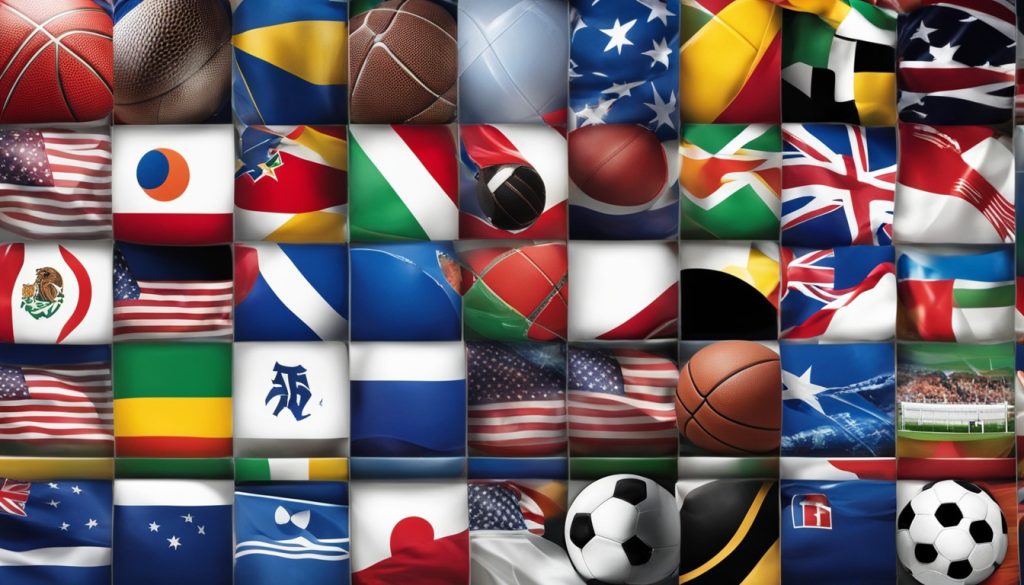Did you know that 71% of fans love watching live sports the most? This fact shows how sports are changing fast. We’re looking at the top 10 sports trends to see how things like demographics, tech, and what fans want are changing sports.
Younger fans, known as Generation Z, are leading these changes. They’re making non-traditional sports more popular. The growth of e-sports and the global reach of big leagues are also big changes. These trends bring new chances and challenges for sports groups.
With more sports news online, it’s key to know these trends. They affect how we watch sports and shape the future of sports business.
The Rising Popularity of Non-Traditional Sports
The world of sports is changing, with non-traditional sports becoming more popular among young people. These include adventure sports and e-sports, drawing in many participants. Data shows more people, especially Generation Z, are choosing these sports for their fun and engaging nature.
Traditional sports are facing challenges in keeping up with these changes. To attract younger fans, organizations need to adapt to these new trends.
Shifts in Participation Rates
More people are now into non-traditional sports than ever before. Even though the NFL is still a big hit, new sports are giving it a run for its money. In 2023, sports fans in the U.S. watched over 1.7 trillion minutes of the top five leagues.
But, traditional sports are losing ground to faster-paced activities. For example, lacrosse saw a huge jump from 250,000 players in 2011 to 830,000 in 2018. This shows a clear shift towards non-traditional sports.
Appeal to Generation Z
Generation Z is changing how we watch sports. They like non-traditional sports for their community feel and the chance to connect with content creators. E-sports and adventure sports are big hits, using social media to bring people together.
Traditional sports are seen as too time-consuming, so games like bocce are gaining fans. With 25 million Americans playing it every year, it’s clear that sports trends are changing. Understanding what Generation Z likes is key to reaching this important group.

Globalization in Sports
Globalization has changed how sports leagues work and connect with fans worldwide. Leagues like the NBA and Premier League now reach fans everywhere, not just at home. Thanks to global sports media, fans can follow their favorite teams and players from anywhere.

The Worldwide Reach of Major Leagues
International sports leagues are growing fast. Players from all over the world are joining teams in the U.S., making leagues more popular. For example, Yao Ming made the Houston Rockets a big hit in China, gaining thirty million new fans.
Events like the World Cup and Olympics bring athletes together from around the globe. Now, regular-season games in football and hockey are played in different countries. Foreign soccer teams also tour the U.S., sharing their culture with fans.
Media and Sponsorship Insight
How we watch sports is changing fast. Streaming services are getting more popular, especially with Generation Z. They like to watch sports on demand and enjoy short, exciting clips.
Media companies are buying rights to sports events to reach more fans worldwide. This helps leagues grow their audience. Sponsorships are also booming as companies see the value in connecting with a growing middle class globally. The future of sports looks more connected, with leagues needing to be creative to keep fans interested.
Game-Changing Rise of E-Sports
E-sports has quickly become a big part of the sports world, drawing in millions and making a lot of money. It’s set to hit USD 2.06 billion by 2024. This shows how competitive gaming has grown and how many people watch it.
Industry Growth and Viewer Statistics
From 270 million in 2016, the e-sports audience grew to 495 million by 2020. This shows a big change in what people like to watch for fun. By 2021, esports viewers in the U.S. could be more than baseball and basketball fans, with 84 million watching.
This shows how much younger people love esports. It’s clear they’re really into it.
| Statistic | 2020 Estimate | 2024 Projection |
|---|---|---|
| Global E-sports Audience | 495 million | 2.06 billion market value |
| U.S. E-sports Viewers | N/A | 84 million |
| Hours of E-sports Content Watched | 11 billion | N/A |
Engagement of Young Audiences
Young people, especially those 18 to 34, really love multiplayer video games and competitive gaming. This age group makes up 73% of the e-sports audience. As gaming becomes more social, marketing is targeting young fans to keep e-sports popular.

Integration of Artificial Intelligence
Artificial intelligence is changing sports management in big ways. It’s helping improve player performance and make watching sports more fun for fans. By using AI, teams can find new talent and give fans unique experiences.
AI’s Role in Player Scouting and Health
AI is changing how teams find new players. It looks at lots of data to see who has the most potential. The sports AI market is expected to hit $19.9 billion by 2030. Teams are spending a lot on AI to get better at finding players.
AI looks at game data, including how players move and their health. From 2015 to 2018, the NBA checked over 25,000 games and found over 2,000 mistakes. This shows how important AI is in making smart choices.
AI also helps keep athletes healthy and train them better. For example, the NFL is working with AWS to use sensors to prevent injuries. This helps athletes stay in top shape and reduces time off.
Fan Engagement Through AI
AI is key to making fans feel more connected to sports. Fans want more interaction and content that’s just for them. AI helps make this happen by looking at what fans like and sending them special content.
AR technology is also becoming a big deal in sports. It makes watching games more exciting and interactive. The sports analytics market is expected to grow to $22 billion by 2030. This shows how big a role AI plays in sports.
| Aspect | Impact of AI | Market Outlook |
|---|---|---|
| Player Scouting | Enhanced talent identification through performance metrics | $19.9 billion by 2030 |
| Injury Prevention | Predictive analysis for reducing risk and optimizing health | Rising demand in sports organizations |
| Fan Engagement | Personalized content and immersive experiences through AR | $22 billion sports analytics market by 2030 |
| Performance Analysis | Improved training strategies and real-time game analytics | Growth in data-driven decision making |
The Importance of Data Analytics and Sensors
In today’s sports world, using data analytics and sensors is key. These tools help teams and coaches make the most of athlete performance and keep them healthy. They provide real-time data that’s crucial for making smart decisions, keeping athletes in top shape all season.
Real-Time Performance Metrics
Sensors have changed how teams check player performance. With wearable tech like the Zephyr BioHarness, coaches get instant info on heart rate and movement. This info is key for:
- Predicting injuries by watching workload and recovery.
- Enhancing training with programs made just for athletes.
- Strategically adjusting gameplay by analyzing opponents in real-time.
Health Monitoring for Athletes
Thanks to advanced analytics, athlete health monitoring is better than ever. These tools spot injury risks and offer steps to prevent them. The benefits of these systems are:
- Data-driven recovery plans to keep athletes healthy.
- Bespoke training schedules that boost performance and avoid overtraining.
- Detailed analysis of biomechanics, leading to better techniques and fewer injuries.
Blockchain Technology’s Role in Sports
Blockchain technology is changing the sports world. It’s helping teams and leagues connect better with fans and run smoother operations. This tech lets sports groups improve how they interact with fans and manage things.
Transparent Transactions and Fan Engagement
Blockchain is making sports transactions clear and honest. This is key for things like ticket sales, where fraud is a big worry. With blockchain, every ticket can be checked to make sure it’s real, cutting down on fake tickets.
It also brings in new ways for fans to earn and enjoy. By using fan tokens and loyalty programs, teams build stronger communities. Fans get a say in what happens with their favorite teams.
Safe Betting Practices
Blockchain is key in making sports betting safer and more controlled. It makes sure all bets are recorded and can be checked, building trust with users. Smart contracts help automate betting, cutting down on arguments and making sure games are fair.
But, there are still challenges like rules and teaching people about blockchain. Yet, the benefits for safe and clear betting are big.
Increasing Focus on Fan Engagement Strategies
Today’s sports world needs a stronger bond with fans. Teams are using new ways to keep fans coming back. Digital tools are key in building these connections, letting teams talk directly with their fans. Through mobile apps and social media, teams can share content that speaks to fans on a personal level.
Emerging Digital Tools for Fan Interaction
Digital tools have changed how teams connect with fans. They offer real-time chats, personalized content, and deep experiences. For example:
- Brands found that fans of women’s sports are 30% more likely to engage with marketing compared to men’s sports.
- Streaming platforms saw a 20% increase in spending from fans of women’s sports over their male counterparts.
- Innovative strategies, like microbetting, are reshaping engagement by providing real-time experiences with low-risk stakes.
With data analytics, teams can make experiences for different fans. This means engagement is not just wide but also personal, fitting what fans like.
Creating Memorable Experiences
Memorable sports experiences are key to keeping fans engaged. Teams are using VR and AR to make games and events more interactive. These tools not only engage fans but also open up new ways to work with sponsors. Some trends show:
- Cristiano Ronaldo’s move to the Saudi Pro League boosted revenue by 650%.
- Lionel Messi’s transfer to Major League Soccer doubled the MLS Season Pass subscribers on Apple TV.
- Taylor Swift’s presence during a Chiefs-Jets game increased female viewership ratings by over 50% for viewers under 18.
These strategies show how important it is to build strong fan communities. With AR workouts and interactive games, teams become part of a lively sports world.
The Shift to Subscription Video on Demand (SVOD)
SVOD is changing how sports fans watch their favorite teams and events. More than 30% of viewers subscribe to watch sports because of the ease and access these platforms offer. In the U.S., households spend about $61 a month on four SVOD services, showing how much people value digital sports viewing.
Rise of Streaming Services in Sports
Now, 72% of consumers feel there are too many subscriptions to keep up with. The competition among streaming services is fierce. Live streaming makes up 63% of the video market and is expected to grow to $252.76 billion by 2029. Millennials and Gen Z are leading the move to watch sports through streaming.
Enhanced Viewing Experiences
Sports organizations are adding features like real-time stats and different camera angles to keep viewers interested. These features make watching sports better and help keep viewers from switching channels. About 53% of young viewers are more likely to switch channels, so offering unique content is key. As SVOD grows, being adaptable and innovative will help platforms succeed.
FAQ
What are the top sports trends to watch in the coming years?
The top sports trends include the rise of non-traditional sports and globalization of leagues. E-sports and the use of artificial intelligence are also big. Data analytics, blockchain technology, and enhanced fan engagement are key. The shift to subscription video on demand, social commerce, and hyper-personalization of fan experiences are also important.
How is globalization affecting sports organizations?
Globalization lets major leagues reach fans worldwide. The NBA and Premier League use media tech and sponsorships to connect with fans globally. They need strategies for sustainable growth.
Why are non-traditional sports gaining popularity among younger audiences?
Younger fans, especially Gen Z, like non-traditional sports like e-sports and adventure sports. These sports offer fast-paced, immersive experiences that fit their lifestyle and social media habits.
What role does data analytics play in sports?
Data analytics and sensor technology track athlete performance and health. Real-time metrics help coaches make better decisions during games. They also help in preventing health issues to keep athletes well.
How is blockchain technology transforming the sports industry?
Blockchain technology makes transactions secure and transparent. It helps prevent ticket fraud and supports safe betting. It also offers new ways for fans to engage, like digital collectibles.
How can sports organizations enhance fan engagement?
Sports organizations use digital tools like mobile apps and social media for ongoing fan interactions. Tailoring content and creating community experiences builds emotional connections. This increases loyalty and attendance.
What impact does e-sports have on traditional sports viewership?
E-sports is growing fast, drawing in young viewers. It offers an alternative to traditional sports. This might lead to less viewership for traditional sports, pushing them to innovate.
What are the benefits of using artificial intelligence in sports?
Artificial intelligence helps with scouting players, optimizing training, and improving fan experiences. It delivers personalized content. This technology keeps organizations competitive.
How is the subscription video on demand model impacting sports content consumption?
Fans now prefer SVOD for flexible sports content viewing. This has led to better viewing experiences, like extra camera angles and live stats. Organizations aim to meet these new expectations.


